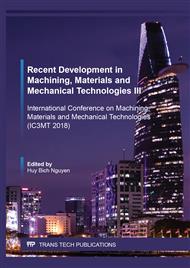p.77
p.84
p.92
p.99
p.106
p.114
p.123
p.129
p.140
The Influence of Magnetic Fiber Orientation on the Electric Properties of Conductive Polymer Composite Material by Using Magnetic-Assisted Injection Molding
Abstract:
With the evolution of modern science and technology, composite material is widely used in more and more fields. Its related fabrication and technology have become the important issue of development of science and engineering. Especially for fibrillar composite material, since the fiber’s orientation and distribution affect the properties of product, how the orientation and distribution are controlled is an important key to improve its properties. In this study, the external magnetic field is applied to injection molding for controlling the orientated behavior of metal fiber during the filling process. In addition, the fiber’s orientation and conductivity will be investigated by means of different process conditions (melt temperature, mold temperature, injection speed, and so on) with or without external magnetic field.
Info:
Periodical:
Pages:
114-122
Citation:
Online since:
October 2019
Authors:
Price:
Сopyright:
© 2019 Trans Tech Publications Ltd. All Rights Reserved
Share:
Citation:


